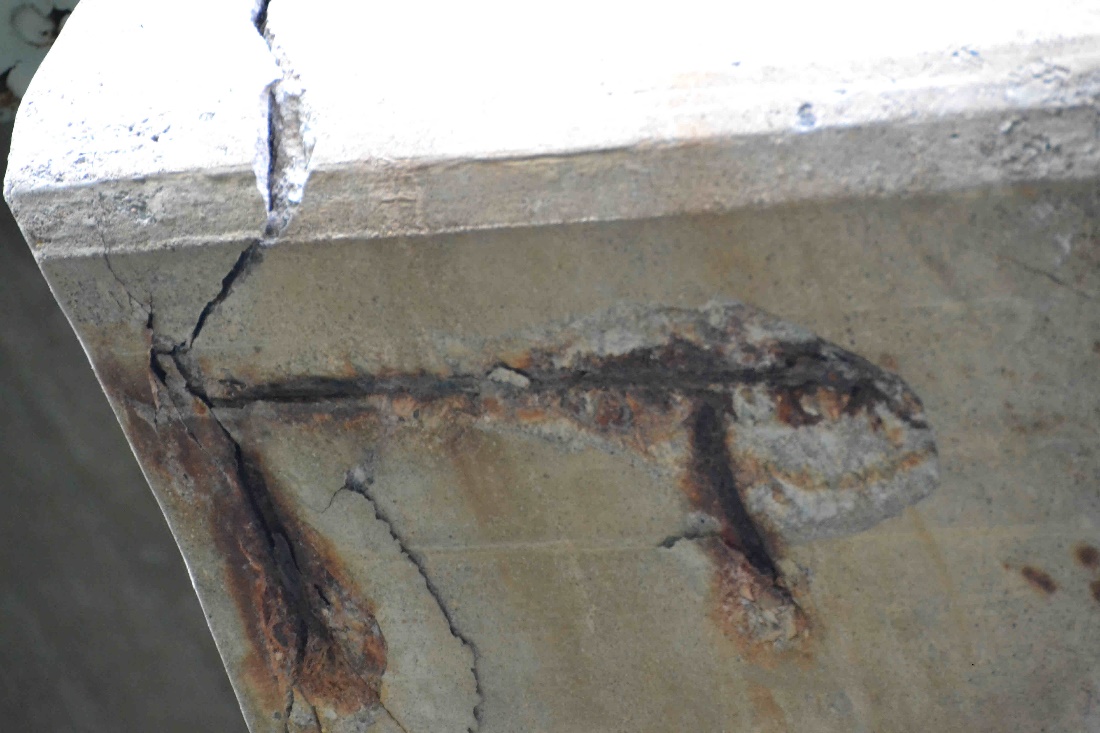Chapter C10 – Installs Grout and Repairs Concrete

Source: https://commons.wikimedia.org/wiki/File:Qew_bruecke_nf_beton_kaputt_34_von_46.jpg
Improper Curing can result in many concrete defects such as:
- Dusting
- Scaling and Mortar Flaking
- Popouts
- Crazing
- Plastic Shrinkage Cracking (dry shrinkage)
- Discolouration
Repair techniques
For concrete repairs to have a lasting effect proper binding is needed between the old surface and the repair grout, epoxy or topping mix. Surfaces can be cleaned and removed using:
- High pressure water spraying (or steam)
- Sandblasting
- Shotblasting
- Scabbling
- Scarifying.
Once the surface has been cleaned and unbonded particles removed it is ready it be patched using a mortar mix. Latex bonding agents can be applied to the area to be fixed to increase adherence between the old concrete and the patch. Epoxies can be used to repair cracks in slabs and foundations.
Epoxy and Cementous grouts have a range of applications including tile, concrete countertops, a levelling compound for floors and machinery. Epoxy grout does not shrink, crack or deteriorate as easily as Cementous grout.
Stains can be removed from concrete using cleaning agents which are made from organic solvents, oxidizing bleaches or acids. Stains can be lifted using a poultice.
Key Competencies
The NOA for Carpenter (2013) identifies the required competencies (skills) for the task of installing grout. These are:
- Select and prepare grout and additives according to job requirements, project drawings and manufacturers’ specifications
- Select, construct and install grout forms
- Prepare surface to be grouted by roughing, cleaning and applying a bonding agent
- Use grout placement methods such as using grout forms, pumping, hand trowelling and dry packing
- Apply appropriate backup material when installing grout on foam insulation products, such as those used for exterior insulated basements (NOA, p. 44).
Review Instruction Sheet (IS) on Brightspace:
CONC 100/122, p. 107 – 135:
- IS 1.1 Define Concrete Defects
- IS 2.1 Describe Concrete Repair Techniques
- IS 3.1 Describe Patching and Repairing Procedures
- IS 4.1 Removal of Stains from Concrete
Review Questions
- Name six problems on concrete surfaces that may require patching and repairing of the surface.
- Describe dusting and its causes.
- Describe scaling and causes.
- What is crazing and how is it caused?
- What are popouts and how are they caused?
- What causes shrinkage cracks?
- Describe a method for checking a concrete slab for moisture coming up through the slab.
- Before patching material is put into the cavity that has been cut out, what should be done to the cavity?
Answer:
-
- Dusting
- Scaling
- Crazing
- Popouts
- Cracking
- Discoloration
- Fine powdery material rubs off the surface of concrete, caused by allowing the concrete to freeze before it cures, exhaust fumes from a heater, or finishing the slab while bleed water is present.
- When mortar on the surface flakes off at a depth of 3-10 mm; caused by using non-air entrained concrete, deicing salts, finishing the slab with bleed water present, and improper curing.
- Fine cosmetic cracks that form on the surface of the concrete which can be caused by allowing the slab to dry out too fast and improper curing.
- Large chips that originate from a piece of aggregate. Caused by porous aggregate that contains water that freezes and expands, pushing the concrete outwards.
- By using too much water in the concrete and by no or poor curing practices. Allowing the concrete to dry out too fast can develop shrinkage cracks.
- Tape a piece of poly to the slab for 24 hours; return and check if moisture has condensed on the sheet.
- Wet it down for an hour or two before the patch is applied. A thin layer of mortar is brushed into the cavity just before the patching is done.
